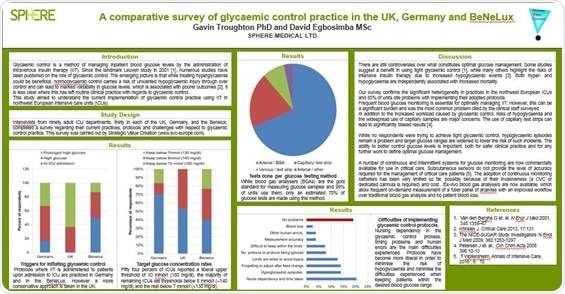Study involving Intensivists from 90 ICUs in northwest Europe confirms significant variability in glycaemic control practices
Sphere Medical, an innovative company in critical care monitoring and diagnostics equipment, has recently presented at the Intensive Care Society State of the Art Meeting and published a scientific poster discussing, “A comparative survey of glycaemic control practice in the UK, Germany and BeNeLux”. Elevated blood glucose is a widely recognised response to critical illness, with around two thirds of patients admitted to the intensive care unit (ICU) requiring intravenous insulin therapy (IIT) in order to avoid hyperglycaemia. However, IIT also carries the risk of hypoglycaemic episodes and injury. Sphere’s study involved Intensivists from 90 adult intensive care units (ICU) and aimed to understand the current practices, protocols and challenges of glycaemic control practice using IIT.

The study confirmed that there are still controversies over what constitutes optimal glucose management in critical care, resulting in its finding that care protocols remain highly variable across northwest European ICUs. 80% of Intensivists surveyed also cited problems with implementing their adopted glycaemic control protocols for a number of reasons. “Blood testing is at the heart of many of these issues. Frequent blood glucose monitoring is essential for optimally managing insulin therapy and protocols often require hourly measurement of blood glucose until patient stability is achieved. Any variations that could affect glucose levels, such as insulin or feed changes, require reverting to hourly measurement until stability is evident,” observed Dr Gavin Troughton, Sphere Medical.
Consequently, the study found that nurse dependency and time taken to undertake the frequent blood glucose monitoring, essential for optimally monitoring IIT, was the most commonly cited issue when implementing protocols. Although arterial blood gas analysers (BGA) are the gold standard for measuring glucose samples, the survey found only 70% of tests were made using this method for IIT monitoring. This means that there is still a widespread use of capillary samples and test strips (potentially to reduce time to result and workloads) that can lead to significantly biased results, or BGA testing may not be undertaken as often as necessary.
To overcome the issues arising around blood testing for IIT, a number of continuous and intermittent systems are now commercially available for glucose monitoring in ICUs. For example, the next generation Proxima™ patient dedicated blood gas analysis system (Sphere Medical, Cambridge, UK) now allows rapid measurement of glucose levels directly at the bedside. This makes rapid and frequent measurement of arterial blood samples easy, supporting better glycaemic control in the critically ill.